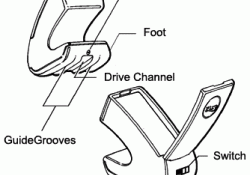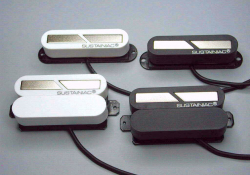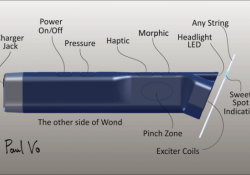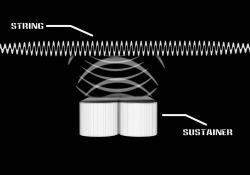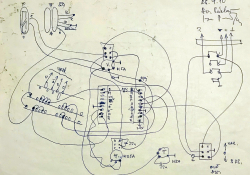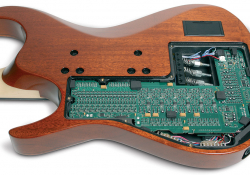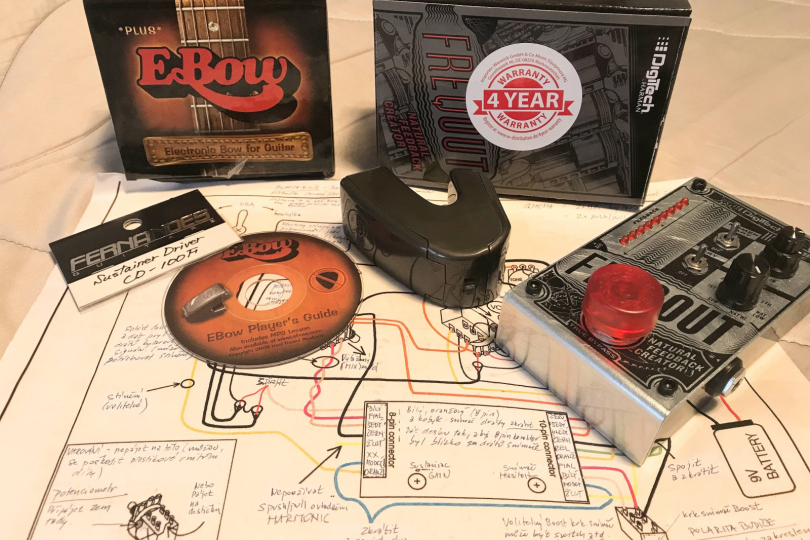
Laboratorium of Dr. Hyenik #4: Infinite Tones
Electric guitarists have always longed for a tuneful extension of tone, and they have tried to achieve it in all sorts of ways. From as dense as possible resonant materials used for the zero frets and bridges, through ultra-strong pickups, really loud amps, magic stompboxes to almost esoteric gizmos like the Fatfinger.
Amplifiers became a welcome help at first, in addition to the desired distortion generating the so-called feedback (under certain conditions), which gradually became an organic part of the music. Think of the Christopher Columbus of guitar feedback – the legendary Jimi Hendrix. However, the feedback is not controllable much and changes according to specific space, so this quest for infinite tone continued on, stopping for a while at the stompboxes.
Effects
The first one to go was, of course, the compressor, officially often called the sustainer. It really does extend the tone, sometimes very significantly, but most of the time, it still would not produce the dreamed-of infinitely singing lead tone. Also, the sound waveform is somewhat different, and moreover, at such extreme settings, often together with more distortion, unwanted noise increases quite dramatically. But it's one of the options, and David Gilmour, for example, achieves a beautifully long singing tone with the right combination of boxes. And when he backs it up with his clever "sound on sound" approach, he really gets into the realms of infinite sustain. A similar freeze/hold function then worked its way into the repertoire of various reverb or delay multi-effects until the special EHX Freeze ((already in three variants) was made, which is great to work with, especially in the background (a short repeating section behaving as an infinite tone), but also atmospherically or ambiently.
After the half-forgotten Boss Feedbacker, the "natural feedback creator" (as Digitech's marketing department puts it) has finally appeared. Despite the blemishes mentioned in the review (it helps to have the FreqOut right behind the guitar, by the way), I think it's the easiest way into the realm of the infinite, as there are no special techniques to learn, no complicated things to assemble into the guitar, etc. Even though (incomprehensible to me) Digitech got rid of the development team responsible for several interesting stompboxes and the de facto rise of the company (by then staggering wearily in the guitar effects market), you can still occasionally get one in the sales – in that case don't hesitate.
EBow
But let's forget about the boxes, the crowned king of the infinite realm has been the so-called EBow electronic bow since the 70s. It can be heard on hundreds of recordings, the most iconic and well-known of which is probably U2 – "With or without you". Its definition, from a well-protected patent that more or less eliminated possible competition for twenty years, says: a monophonic handheld electromagnetic string exciter, which is pretty much saying it all. Inventor Greg Heet didn't deal with the subsequent modification of the guitar sound but took a proactive approach to the problem, vibrating the string electromagnetically and thus independently of the guitar and for as long as he wanted (until the battery ran out). The EBow was a revolution in a way, and some other followers have appeared only recently, kind of locking the stable door after the “sustain” has bolted, because the EBow doesn't cost a fortune anymore, and you don't have to undergo a fiendish task of finding/shipping/declaring it from the US (those used to be the hard times, children). Nowadays, you can buy it for a song, and the rest you need is... just practice. If you'd like to try the more sophisticated TC Aeon or the slightly cheaper Joyo, ambient guru Bill Vencil can be of help.
At EBow, they've worked hard to promote the product and include a mini-CD with the bow, featuring cute animated and wonderfully illustrative tutorials. After all, since times have moved on and not many people play CDs anymore, they can, of course, be downloaded from the website. With a "little" practice, you can thus imitate cello, harmonica, trumpet or violin arpeggios quite faithfully, and extend the tones indefinitely. With sensitive control, it even works partially on acoustic guitars and other stringed instruments. My only criticism thus goes to ergonomics. Apparently, I haven't practised enough, so I still can't shake the feeling of a certain clumsiness and foreign object in my hand, not to mention the clumsy switching between normal and cool harmonic mode.
This seems to have caused the inventors to look for other options, excluding DIYs like ladies' leg shaver by Adam Jones (Tool), drill with a fastened pick (Mr.Big) or the dildo vibrator used by the sad hero Lips to make a splash at festivals in metal's "prehistoric" days (have you seen the documentary Story Of Anvil?). The tireless innovator Paul Vo (Moog) was trying to come up with the ultimate improved electromagnetic pick, the Wond, which was supposed to be more ergonomic, more powerful, independent of obsolete batteries, but most importantly with haptic (touch) control of expressiveness, which made me support his crowdfunding project. However, there was a catch with regular payments from my Paypal account (fortunately) because even within five years since the project was launched, there are unfortunately no satisfactory results (the first test series didn't have much positive feedback). So let's see if this start-up will show something more tangible in the future. And that's literally it, because live control is not less than paramount here. Which gave way to special guitar pickups.
Sustainers
This is because they work on the same electromagnetic string shimmy as an ebow, but they're mounted in place of a neck pickup, which brings one huge advantage and a couple of disadvantages. The great thing is that you don't have to learn anything new, you just play as you are used to – with an infinite tone on top of it. At the cost of "losing" the neck pickup plus the installation is not the easiest of things. Incidentally, the attached picture below of my Sustainiac's wiring design says it all. However, this ergonomic ace trumps all, and it is then possible to perform similar stage magic using breath and tongue as the famous Steve Vai.
There are two stable manufacturers currently working on this complex subject. The aforementioned Sustainiac and the guitar company Fernandes. Of course, their drivers are often fitted to guitars from other manufacturers such as Schecter, Ibanez or Manson. Since I own both of them, I dare to compare them. In the final tally, Sustainiac leads the way, despite their not-so-much-cute but rather desperately outdated websites and the resulting confusing information, which is a shame for such a complex product. But the Sustainiac is significantly smaller in size, so the guitar intervention doesn't have to be as invasive, and with some user feedback incorporated, it has a full neck pickup sound from the Stealth range (with the sustainer off). To my ear, it's a standard quality single coil sound, which, while probably not going to satisfy boutique gourmets, is perfectly satisfactory to me.
The installation itself was, however, a tough nut to crack, as I had to study and translate all the documentation for a non-English speaking luthier and, on top of it, deal with such gadgets that I didn't want to constantly replace the classic 9V battery (quite some consumption), so I cleverly used the existing case with six rechargeable NiMH pencil batteries. However, these didn't total the usual 1.5V, but only about 1.3V, so they didn't give the required voltage in total. I got special rechargeable alkaline batteries then, which did have 1.5 V, but they leaked unprecedentedly after a while, so they were discontinued altogether. In the end, I pragmatically solved this with IKEA batteries, which I simply replace as needed for peanuts. Pioneers never have it easy.
Fernandes offers two sets and the information provided is on a completely different level, but the fitted board is significantly larger and the users have complained about the neck pickup sound. I have it installed on a fretless guitar, so I can't judge it completely objectively. They both have additional harmonic modes (Sustainiac has several of them) to mess around with and spice up the music excellently. If you're brave and skilful enough, I find this method the best for getting the magical infinity, even if it is the most complex and expensive. Of course, that's the way it is in life, isn't it?
In addition, some guitarists desire a polyphonic sustainer that extends multiple tones at once, such as a whole chord. These desires were temporarily fulfilled by the aforementioned Paul Vo with his Moog Guitar E1, a design gem packed with a plethora of features and modes. And this was matched by a very high price tag. Nowadays, you can only find it on the second-hand market, because it hasn't caught on (despite its interestingness). Maybe also due to the fact that guitarists do not really need a polyphonic sustainer, the sound is more like a synth and not completely natural. Of course, a monophonic sustainer (like all the previous examples) extends all the notes first until the strongest one comes out in the form of well-known feedback, to which our ear is more accustomed.
Miscellaneous
Not counting another innovation incubator like KMI with their still only prototypical StrongArm sustain bridge or the technological ramblings of the meanwhile completely fizzled out Sixtainer, the analogue whiff of an honest product is the Gizmotron, where the infinite tone is created by rubbing the toothed wheels against the string. Unfortunately, despite all the modern kickstarter campaigns, the renewed production of the old idea has either gotten a bit behind the times or overestimated its technological capabilities, as the reactions to the extreme demands of installation precision and subsequent (un)reliability are not at all positive, so, in the end, the best thing about it is the cool name, and I'm only mentioning it as a funny detail at the end.
I have tried to shed some light on an area shrouded in a slight fog of mystery and comment with my personal real-world experiences. Infinite sustain is a great element in ambient atmospheric music, but also in more standard music, as my colleague always glosses that Phil Collen (Def Leppard) plays all his solos with sustain. However, each approach described above has its pros and cons, and they intersect and complement each other in various ways, rather than one completely replacing the other. Which proves that there are several left in my portfolio. I like them all and use them as I feel and depending on the particular occasion. Next time we'll look inside the acoustic guitar with another tricky topic codenamed soundport.
If you have found an error or typo in the article, please let us know by e-mail info@insounder.org.

